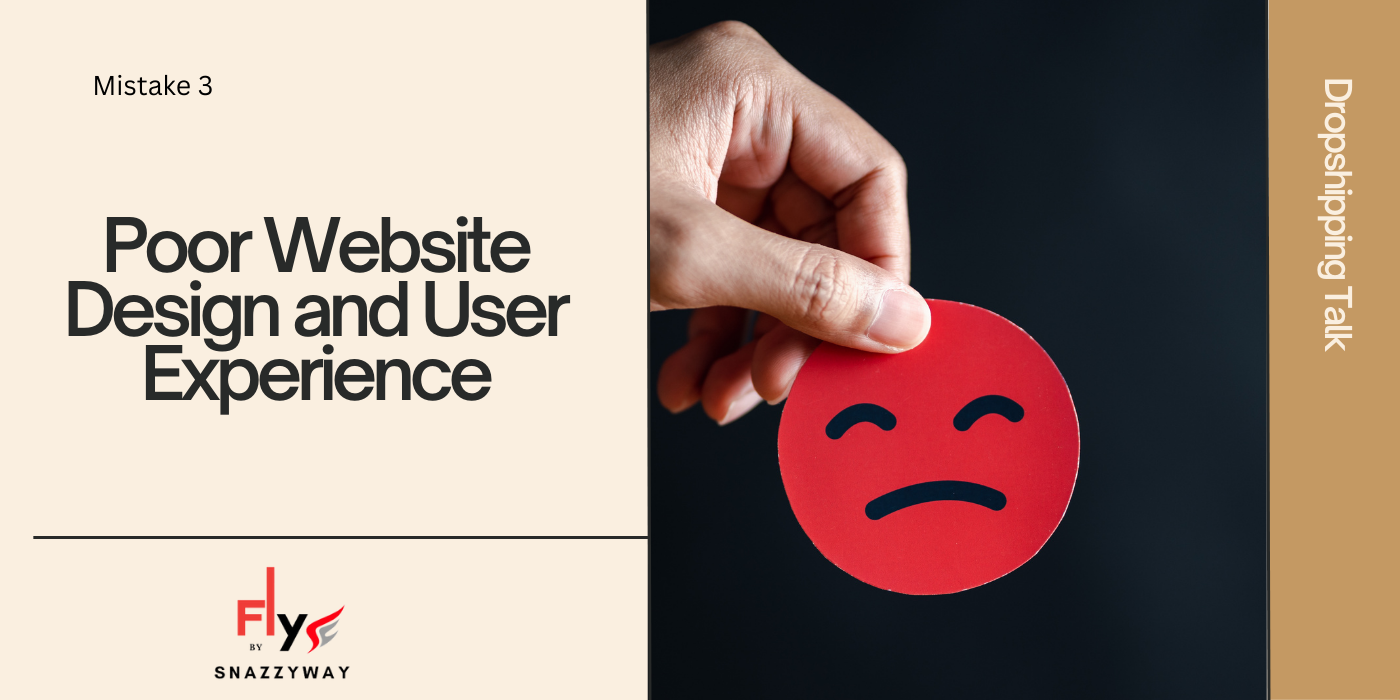
Top 7 Common Dropshipping Mistakes and How to Avoid Them !
Dropshipping has changed the way people start online businesses, making it easy and affordable for anyone to begin. Since you don’t need to store products or handle shipping, it’s an attractive option for new entrepreneurs. However, the process isn’t as simple as it seems. Many dropshippers make mistakes that can lead to problems and financial losses.
In this guide, we’ll explore the top 7 common dropshipping mistakes and how to avoid them. Whether you’re just starting or already experienced, knowing these pitfalls can help you run your business smoothly and grow successfully.

Mistake 1: Choosing the Wrong Niche
One of the most critical decisions in dropshipping is selecting the right dropshipping niche. Your niche determines the products you’ll sell, your target audience, and your overall market positioning. Choosing the wrong niche can lead to various challenges, such as low demand, high competition, and difficulty in marketing.
Importance of Niche Selection
A well-chosen niche can make or break your dropshipping business. It should align with your interests and expertise while also having sufficient market demand. A niche that you’re passionate about will keep you motivated, but it’s equally essential to ensure that there’s a market willing to purchase the products.
How to Choose the Right Niche
Research Market Demand: Use tools like Google Trends, keyword research, and competitor analysis to gauge market demand. Look for niches with consistent or growing interest over time.
Evaluate Competition: Analyze the competition within your chosen niche. High competition can be challenging for new dropshippers, so consider finding a niche with moderate competition where you can differentiate yourself.
Assess Profit Margins: Consider the potential profit margins in your niche. Some niches may have low-cost products but also low margins, making it difficult to achieve profitability.
Consider Your Passion and Knowledge: While profitability is crucial, choosing a niche you’re passionate about can make your business journey more enjoyable and sustainable.
Case Studies/Examples
Success Story: A successful dropshipper identified a profitable niche in the lingerie market, focusing on unique and high-quality products that catered to specific customer needs. By carefully selecting products that stood out from generic offerings and targeting a specific audience, they were able to differentiate themselves from competitors. The dropshipper’s focus on quality, along with excellent customer service and effective marketing strategies, helped them build a loyal customer base. This niche choice allowed them to thrive in a specialized market with higher profit margins and less direct competition.
Failure Story: In contrast, another dropshipper ventured into the crowded market of generic phone accessories without a clear unique selling proposition. The market was already filled with numerous competitors offering similar products at low prices, leading to intense competition and razor-thin profit margins. Without a distinctive angle or value-added service, the dropshipper struggled to attract and retain customers. The lack of differentiation, combined with the inability to compete on price alone, made it difficult to grow the business. Ultimately, the challenges of scaling in such a saturated market led to the business’s closure.
Actionable Tips to Avoid This Mistake
- Conduct thorough market research before settling on a niche.
- Test different niches with a small product range before fully committing.
- Focus on niches with passionate communities, as they are more likely to engage with your brand.

Mistake 2: Failing to Thoroughly Evaluate Suppliers
A key to success in dropshipping is working with reliable suppliers. However, many dropshippers skip the important step of thoroughly checking their Clothing dropshipping suppliers before partnering with them. This can lead to problems like bad product quality, slow shipping, and poor communication, which can hurt your business’s reputation and make customers unhappy.
The Role of Suppliers in Dropshipping
In dropshipping, suppliers are responsible for making, packaging, and shipping the products directly to your customers. As a dropshipper, your job is to sell these products, but your success depends heavily on your suppliers’ performance. That’s why it’s crucial to choose trustworthy and capable suppliers to ensure a good customer experience.
Common Supplier-Related Problems
- Poor Product Quality: Without checking suppliers properly, you might get low-quality products, leading to complaints and returns.
- Delayed Shipping: Unreliable suppliers may not stick to the agreed shipping times, causing delays that can annoy customers.
- Lack of Communication: Some suppliers may be hard to reach or slow to respond, making it difficult to resolve issues.
- Inconsistent Inventory: Suppliers who don’t keep you informed about stock levels can cause you to run out of products, leading to lost sales.
- Hidden Costs: Some suppliers might have hidden fees or unclear pricing, which can affect your profits.
Tips for Checking Suppliers
Ask for a Free Trial: Some suppliers may offer a free trial period or sample products at a reduced cost. This can give you a chance to evaluate the product quality and service without a significant upfront investment.
Assess Product Quality: Use the free trial to closely inspect the products for quality, durability, and packaging. This will help you determine if the products meet your standards and those of your customers.
Test Shipping and Handling: During the trial, monitor how the supplier handles the order, including packaging, shipping time, and delivery. This will give you insight into their logistics and whether they meet your expectations for speed and care.
Evaluate Customer Service: Interact with the supplier’s customer service team during the trial. Pay attention to their responsiveness, helpfulness, and ability to resolve issues, as this is crucial for ongoing business relationships.
Clarify Terms and Conditions: Use the trial period to discuss and clarify important terms, such as return policies, payment terms, and any other conditions that may affect your partnership.
Analyze Overall Experience: After the free trial, evaluate the entire experience. Consider factors like product quality, communication, and reliability. This assessment will help you decide if the supplier is a good fit for your business.
How to Avoid This Mistake
- Start Small: Start with small orders to test the supplier’s reliability and product quality.
- Build Relationships: Communicate regularly and build a good relationship with your suppliers to foster trust.
- Monitor Performance: Keep track of how well your suppliers perform and be ready to switch if they don’t meet your standards.
By carefully checking your suppliers, you can ensure smoother operations, happier customers, and a more successful dropshipping business.

Mistake 3: Poor Website Design and User Experience
Your website is the face of your dropshipping business. If it’s not designed well or doesn’t provide a good user experience, you risk losing potential customers and sales. A poorly designed website can create confusion, frustrate visitors, and drive them away to competitors.
The Importance of Website Design and User Experience
A well-designed website not only attracts customers but also makes it easy for them to find and purchase products. Good website design and user experience (UX) are crucial for:
- Building Trust: A professional-looking site helps build credibility and trust with your audience.
- Increasing Conversion Rates: An intuitive and user-friendly design can lead to higher conversion rates by making the shopping process easier and more enjoyable.
- Reducing Bounce Rates: A well-organized site keeps visitors engaged and encourages them to explore more pages, reducing the likelihood that they’ll leave your site quickly.
Common Website Design and UX Issues
- Cluttered Layout: Overloaded pages with too much information or too many elements can overwhelm visitors and make navigation difficult.
- Slow Load Times: A slow website can frustrate users and lead to higher bounce rates. Speed is crucial for maintaining visitor interest.
- Unclear Navigation: Poor navigation design can make it hard for users to find what they’re looking for, leading to a frustrating shopping experience.
- Non-Responsive Design: A website that doesn’t work well on mobile devices can alienate a significant portion of your audience who shop on their phones or tablets.
- Inconsistent Branding: An inconsistent or unprofessional appearance can make your business seem unreliable and untrustworthy.
- Difficult Checkout Process: A complex or lengthy checkout process can lead to abandoned carts and lost sales.
Tips for Improving Website Design and User Experience
Simplify Navigation: Create a clear and logical menu structure that makes it easy for visitors to find products and information.
Optimize for Speed: Ensure your website loads quickly by optimizing images, reducing unnecessary scripts, and using reliable hosting.
Make It Mobile-Friendly: Use a responsive design that adjusts to different screen sizes and devices, ensuring a smooth experience for all users.
Use High-Quality Visuals: Invest in high-quality images and graphics that showcase your products effectively and make your site visually appealing.
Ensure Consistent Branding: Maintain a cohesive design and branding throughout your site to build trust and reinforce your brand identity.
Streamline the Checkout Process: Simplify the checkout process to reduce friction and make it as quick and easy as possible for customers to complete their purchases.
Incorporate User Feedback: Regularly gather and analyze feedback from users to identify areas for improvement and make necessary adjustments.
Test and Optimize: Continuously test different design elements and features to see what works best for your audience. Use A/B testing and analytics to make data-driven decisions.

Mistake 4: Overcomplicating the Product Range
Offering too many products can dilute your brand and create confusion for customers. While it might seem like having a vast product range could attract more customers, it can actually lead to several issues that hinder your dropshipping business.
The Dangers of an Overcomplicated Product Range
Customer Overwhelm: A large number of choices can overwhelm potential buyers, making it harder for them to make decisions. This can lead to decision paralysis and abandoned carts.
Increased Complexity: Managing a wide variety of products increases operational complexity. This can complicate inventory management, supplier relationships, and order fulfillment.
Brand Dilution: Offering too many unrelated products can weaken your brand identity. Focusing on a niche helps you build a strong, recognizable brand.
Higher Marketing Costs: Promoting a broad range of products can lead to higher marketing costs and less effective campaigns. It’s often more efficient to focus on a few key products or categories.
Quality Control Issues: A diverse product range can make it challenging to maintain consistent quality across all items, potentially affecting customer satisfaction.
How to Simplify Your Product Range
Focus on a Niche: Specialize in a particular category or type of product that aligns with your brand and target market. This helps you build expertise and stand out from competitors.
Analyze Sales Data: Use data to identify which products are performing well and which are not. Focus on promoting and expanding your best-selling items.
Test and Iterate: Start with a smaller range of products and gradually expand based on customer feedback and sales performance. This allows you to test the market without overcommitting.
Streamline Your Offerings: Evaluate your product range regularly and remove underperforming or redundant items. This helps keep your catalog focused and manageable.
Enhance Product Descriptions: Ensure that your product descriptions are detailed and informative. This helps customers make informed decisions, even if you offer a more limited range.
Use Data-Driven Insights: Leverage analytics and customer feedback to guide your product selection and ensure you’re meeting your audience’s needs effectively.
Build a Strong Brand Identity: Ensure that your product range aligns with your brand’s identity and values. A cohesive product offering helps reinforce your brand’s message and appeal.

Mistake 5: Ineffective Marketing Strategies
Marketing is crucial for driving traffic to your dropshipping store and converting visitors into customers. However, many dropshippers struggle with ineffective marketing strategies that fail to generate results. Without a well-thought-out marketing plan, your store may not reach its full potential, and you could miss out on valuable sales opportunities.
Common Issues with Ineffective Marketing Strategies
Lack of Targeting: Broad or generic marketing efforts can waste resources and fail to connect with your ideal customers. Effective marketing requires targeting specific audiences who are most likely to be interested in your products.
Unclear Value Proposition: If your marketing messages don’t clearly communicate the unique benefits and value of your products, potential customers may not understand why they should choose your store over competitors.
Inconsistent Branding: Inconsistent or unclear branding can confuse customers and undermine trust. Your marketing materials should consistently reflect your brand’s identity and message.
Poor Use of Social Media: Not utilizing social media effectively or failing to engage with your audience can limit your reach and impact. Social media is a powerful tool for building brand awareness and driving traffic.
Ignoring SEO: Neglecting search engine optimization (SEO) can hinder your website’s visibility in search engine results, making it harder for potential customers to find you online.
Ineffective Advertising: Running ads without a clear strategy or failing to optimize them based on performance can lead to wasted ad spend and lower returns on investment.
Lack of Data Analysis: Failing to analyze marketing data and performance metrics can prevent you from understanding what’s working and what’s not, making it difficult to adjust your strategies effectively.
Tips for Developing Effective Marketing Strategies
Define Your Target Audience: Clearly identify who your ideal customers are based on demographics, interests, and behavior. Tailor your marketing efforts to reach and appeal to this audience.
Craft a Clear Value Proposition: Clearly communicate the unique benefits of your products and why they’re valuable to your target audience. Your value proposition should be evident in all marketing materials.
Maintain Consistent Branding: Ensure that all your marketing materials, from your website to social media posts, consistently reflect your brand’s identity, voice, and message.
Leverage Social Media: Use social media platforms to engage with your audience, share content, and promote your products. Create a content calendar and regularly post updates to keep your audience engaged.
Optimize for SEO: Implement SEO best practices to improve your website’s visibility in search engine results. This includes optimizing product descriptions, using relevant keywords, and building quality backlinks.
Run Targeted Advertising Campaigns: Develop targeted ad campaigns based on your audience’s interests and behavior. Use data-driven insights to optimize ad performance and improve returns on investment.
Analyze and Adjust: Regularly review marketing data and performance metrics to assess the effectiveness of your strategies. Use this information to make data-driven adjustments and improve your marketing efforts.
Test Different Strategies: Experiment with various marketing tactics and channels to see what resonates best with your audience. A/B test different approaches to refine your strategy and maximize results.

Mistake 6: Failing to Optimize for SEO
Search engine optimization (SEO) is essential for driving organic traffic to your dropshipping store. However, many dropshippers overlook SEO or fail to implement it effectively, which can limit their store’s visibility in search engine results. Without proper SEO, your store may not attract the traffic it needs to grow and succeed.
The Importance of SEO for Dropshipping
SEO helps your website rank higher in search engine results pages (SERPs), making it easier for potential customers to find you. Effective SEO can lead to increased visibility, more organic traffic, and higher chances of converting visitors into customers.
Common SEO Mistakes
Ignoring Keyword Research: Not researching and using relevant keywords can prevent your store from ranking for terms that potential customers are searching for.
Poor On-Page Optimization: Failing to optimize individual web pages, including product descriptions, titles, and meta descriptions, can reduce your site’s visibility and relevance.
Neglecting Mobile Optimization: A website that isn’t optimized for mobile devices can lead to a poor user experience and lower rankings in search results.
Not Using Alt Text for Images: Images without descriptive alt text can limit your site’s accessibility and search engine visibility. Alt text helps search engines understand the content of your images.
Ignoring Site Speed: A slow-loading website can negatively impact user experience and search engine rankings. Search engines favor sites that load quickly.
Lack of Quality Content: Failing to create high-quality, relevant content can hinder your ability to attract and engage visitors. Content plays a crucial role in SEO by providing value and encouraging visitors to stay on your site.
Poor Internal Linking: Ineffective internal linking can make it difficult for search engines to crawl and index your site. Proper internal linking helps distribute page authority and improve navigation.
Not Building Backlinks: Backlinks from reputable websites can boost your site’s authority and rankings. A lack of backlinks can limit your site’s ability to compete in search results.
Tips for Optimizing Your Dropshipping Store for SEO
Conduct Keyword Research: Identify and target relevant keywords that potential customers are likely to search for. Use these keywords strategically in your product titles, descriptions, and meta tags.
Optimize On-Page Elements: Ensure that each page on your site has optimized titles, meta descriptions, headers, and URL structures. Include keywords naturally and avoid keyword stuffing.
Ensure Mobile Friendliness: Use responsive design to make sure your website works well on all devices, including smartphones and tablets. Mobile optimization is crucial for both user experience and SEO.
Use Alt Text for Images: Provide descriptive alt text for all images on your site. This helps search engines understand your images and can improve visibility in image search results.
Improve Site Speed: Optimize your website’s performance by compressing images, minimizing code, and using reliable hosting. Fast-loading pages improve user experience and search engine rankings.
Create High-Quality Content: Develop valuable and engaging content related to your products and industry. This could include blog posts, guides, and product reviews that attract and retain visitors.
Implement Internal Linking: Use internal links to connect related pages on your site. This helps search engines crawl and index your site more effectively and improves navigation for users.
Build Quality Backlinks: Focus on earning backlinks from reputable and relevant websites. Engage in outreach, guest blogging, and other strategies to build your site’s authority.

Mistake 7: Not Analyzing Performance Metrics
Understanding how your dropshipping business is performing is crucial for making informed decisions and driving growth. However, many dropshippers neglect to analyze performance metrics or fail to use the data effectively. Without proper analysis, you might miss out on opportunities for improvement and optimization, leading to suboptimal results and missed growth potential.
The Importance of Performance Metrics
Performance metrics provide valuable insights into various aspects of your business, including sales, customer behavior, and marketing effectiveness. Analyzing these metrics helps you:
- Identify Trends: Recognize patterns in customer behavior and sales to make data-driven decisions.
- Optimize Strategies: Fine-tune your marketing, sales, and operational strategies based on actual performance data.
- Measure Success: Evaluate the effectiveness of your strategies and campaigns to determine what’s working and what needs adjustment.
- Improve Efficiency: Spot inefficiencies and areas for improvement to streamline operations and enhance overall performance.
Common Mistakes Related to Performance Metrics
Ignoring Key Metrics: Focusing on irrelevant metrics or overlooking important ones, such as conversion rates, customer acquisition costs, and average order value, can lead to a skewed understanding of your business’s health.
Not Setting Clear Goals: Without specific, measurable goals, it’s challenging to evaluate performance effectively and determine whether you’re meeting your business objectives.
Failure to Track Metrics Consistently: Inconsistent tracking of performance metrics can result in incomplete or inaccurate data, making it difficult to assess trends and make informed decisions.
Overlooking Customer Feedback: Ignoring customer feedback and satisfaction metrics can prevent you from addressing issues and improving the customer experience.
Neglecting A/B Testing: Failing to use A/B testing for different strategies and tactics can limit your ability to identify what works best for your audience.
Not Using Analytics Tools: Relying on manual data collection or not using analytics tools can lead to inefficiencies and missed insights.
Tips for Analyzing Performance Metrics Effectively
Identify Key Metrics: Focus on key performance indicators (KPIs) that align with your business goals, such as conversion rate, customer lifetime value, and return on ad spend.
Set Clear Goals: Define specific, measurable objectives for your business. Use these goals as benchmarks for evaluating your performance metrics.
Use Analytics Tools: Implement tools like Google Analytics, Shopify Analytics, and other performance tracking software to gather and analyze data efficiently.
Track Metrics Regularly: Monitor your metrics consistently to stay updated on performance trends and identify any emerging issues promptly.
Analyze Customer Feedback: Collect and review customer feedback to understand their experiences and identify areas for improvement.
Conclusion
Avoiding common dropshipping mistakes is essential for building a successful online business. By focusing on key areas like effective supplier vetting, optimizing website design, and leveraging SEO, you can significantly enhance your store’s performance and customer satisfaction. Additionally, streamlining your product range and implementing smart marketing strategies will help you stand out in a competitive market. Consistently analyzing performance metrics ensures you stay on top of your business’s health and can make informed decisions. By addressing these pitfalls, you’ll be better positioned to grow your dropshipping business and achieve long-term success.
The most critical mistake is choosing the wrong niche. Many beginners select niches with low demand, excessive competition, or insufficient profit margins.
How to avoid it: Conduct thorough market research using tools like Google Trends and competitor analysis. Look for a balance between your personal passion and actual market demand.
A common error is failing to thoroughly evaluate suppliers, which results in poor product quality and shipping delays.
How to avoid it: Always ask for a free trial or order samples before fully committing. Use this opportunity to test the product quality, shipping speed, packaging, and the supplier's customer service responsiveness.
You may be suffering from poor website design and User Experience (UX). Cluttered layouts, slow load times, and complex navigation confuse visitors and drive them away.
How to avoid it: Simplify your navigation, ensure your site is mobile-friendly, optimize images for faster loading, and streamline the checkout process to reduce friction.
A: No, overcomplicating the product range is a major mistake. Too many choices can overwhelm customers (decision paralysis) and dilute your brand identity.
How to avoid it: Focus on a specific niche. Analyze sales data to identify best-sellers and remove underperforming items. Start small and only expand based on customer feedback.
You might be using ineffective marketing strategies, such as targeting too broad an audience or having an unclear value proposition.
How to avoid it: Clearly define your target audience and unique selling point. Leverage social media, run targeted ads, and constantly analyze your campaign data to see what resonates with your customers.
You are likely failing to optimize for SEO (Search Engine Optimization). Ignoring keyword research, alt text for images, and site speed can make your store invisible to search engines.
How to avoid it: Create high-quality content (blogs, guides), use relevant keywords in product descriptions, ensure your site is mobile-optimized, and build quality backlinks.
Many owners make the mistake of not analyzing performance metrics. Without tracking data like conversion rates and customer acquisition costs, you cannot make informed decisions.
How to avoid it: Set clear, measurable goals. Use analytics tools to track key performance indicators (KPIs) and adjust your strategies based on the trends you identify.
